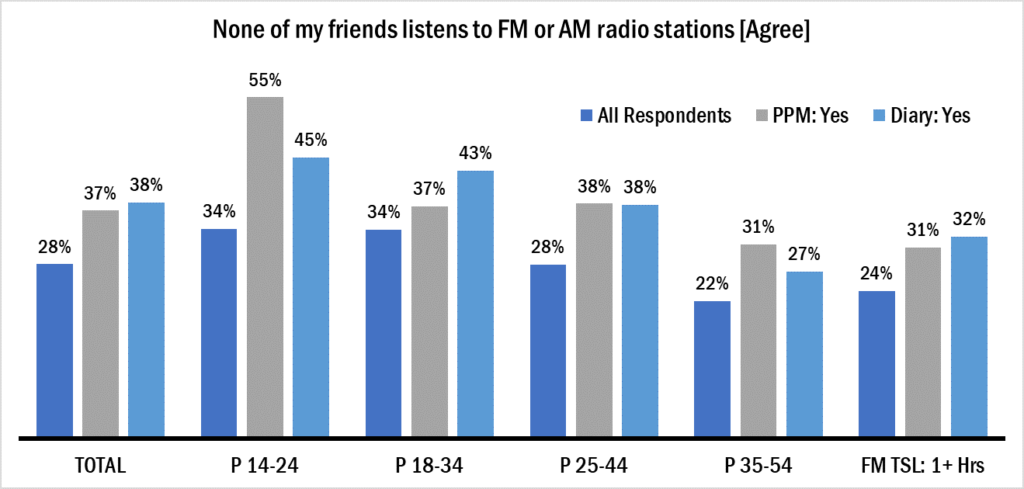True/False: None of My Friends Listens to FM or AM Radio

Perceptual studies used to routinely include measuring “peer group images” – the stations your friends listen to – to make sure that stations weren’t getting closeted. The idea was that if listeners felt they were alone in listening to a station, they might eventually listen less. Peer group images were always strongest among stations with high-profile morning shows and stations with more “foreground” formats. But, even among more “background” formats, we could determine which were getting closeted and then get clients to adopt tactics to get listeners talking about the stations.
Here in 2018, however, it’s become fashionable for people to declare that they don’t listen to AM or FM radio stations at all. It’s part of that same conversation where people talk about giving up landline telephones (in favor of their smartphones), cutting cable TV (in favor of 100% Netflix/Hulu/etc.) and listening exclusively to SiriusXM, Pandora, Spotify and podcasts. Nielsen numbers, however, say that no terrestrial radio listening is uncommon behavior.
In the latest NuVoodoo Ratings Prospects Study, we gave respondents the opportunity to agree or disagree with this statement, “None of my friends listens to FM or AM radio stations.” The number who agreed with that statement is much higher than Nielsen figures would say is true.
Even among psychographics likely to play the Nielsen game (and accept a meter or diary, “PPM: Yes” and “Diary: Yes” in the chart above), we see elevated numbers of people who believe their friends don’t listen to radio. Even among those who listen at least an hour a day to FM, about a quarter overall and almost a third of the ratings likelies believe their friends don’t listen to terrestrial. Naturally, these feelings are stronger among younger demographics, but they’re not insignificant among 35-54’s – the demo containing many of radio’s best consumers.
While it would be easy to dismiss these findings, we’ll suggest that this is an issue radio needs to address. Here are a few ideas:
- Thank listeners for their time regularly. It’s not a mammoth thing, but people respond well to gratitude.
- Find ways to talk about specific listeners on the air; there’s no better way to get people talking about than to talk about them. People love hearing their name on the radio.
- Design a contest where people can enter multiple friends/coworkers to increase the prize they might win (but the friends have to connect in order to validate the process).
- Get out in the community more often. Listeners still like the idea of remotes. Seeing the station pop up in person would inspire talk about the station.
- Aim for being worthy of attention, which is to say, “remarkable.” Do the unexpected. Be “predictably unpredictable.” Radio can be great at doing this. Pandora and Spotify are terrible at it.
- Whatever different things you choose to do, make sure to amplify them using your own air and the power of Social Media.
The best way to push back on the perception that people don’t listen to the radio is to get people talking about radio stations.




